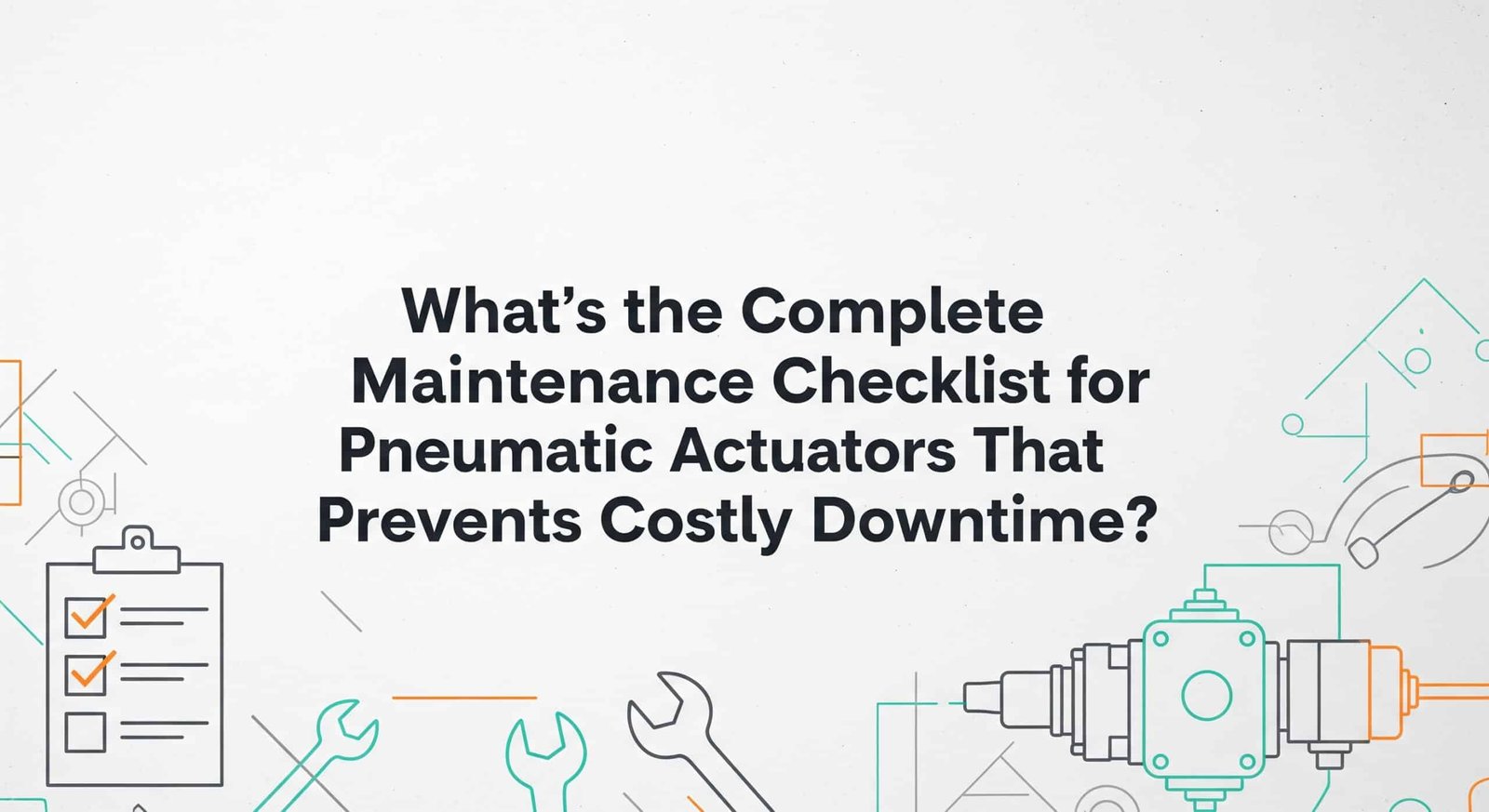Are you waiting for pneumatic actuator failures to force expensive emergency repairs and production shutdowns? 😰 Without a systematic maintenance approach, you’re gambling with your production schedule and letting small issues escalate into major breakdowns that could cost thousands in lost productivity.
A comprehensive pneumatic actuator maintenance checklist includes daily visual inspections, weekly pressure checks, monthly lubrication services, and quarterly seal replacements – following this systematic approach can extend actuator life by 300% while reducing unexpected failures by up to 85%. Preventive maintenance1 is always more cost-effective than reactive repairs.
Last month, I worked with David, a maintenance supervisor at an automotive parts facility in Michigan, who was dealing with frequent pneumatic cylinder failures that were costing his plant $15,000 per breakdown. After implementing our structured maintenance checklist with Bepto replacement components, his unplanned downtime dropped by 90%. 🎯
Table of Contents
- What Should Be Included in Daily Pneumatic Actuator Inspections?
- How Often Should You Perform Preventive Maintenance on Pneumatic Systems?
- Which Components Require the Most Frequent Replacement in Pneumatic Actuators?
- What Are the Warning Signs That Your Pneumatic Actuator Needs Immediate Attention?
What Should Be Included in Daily Pneumatic Actuator Inspections?
Daily inspections are your first line of defense against costly failures! 🔍
Daily pneumatic actuator inspections should include visual checks for air leaks2, unusual noises, proper stroke completion, mounting security, and connection integrity – these 5-minute daily checks can identify 80% of potential problems before they cause system failures. Consistency is key to effective preventive maintenance.

Essential Daily Inspection Points
| Inspection Item | What to Check | Action Required |
|---|---|---|
| Air Leaks | Listen for hissing sounds | Mark for repair if detected |
| Stroke Movement | Full extension/retraction | Investigate any restrictions |
| Mounting Bolts | Tightness and alignment | Retighten if loose |
| Air Lines | Secure connections | Check for damage or wear |
| Operating Pressure | Gauge readings | Verify within specifications |
Visual Inspection Checklist
External Components:
- Rod surface condition (for standard cylinders)
- Seal housing integrity
- Air line connections
- Mounting bracket security
- Pressure gauge readings
Performance Indicators:
- Smooth operation throughout stroke
- Consistent cycle times
- No unusual vibrations or noises
- Proper end-position cushioning
Documentation Requirements
Maintain daily inspection logs to track:
- Operating pressures
- Cycle counts
- Any abnormalities observed
- Corrective actions taken
This data helps predict maintenance needs and optimize replacement schedules for maximum cost savings.
How Often Should You Perform Preventive Maintenance on Pneumatic Systems?
Strategic maintenance scheduling maximizes equipment life while minimizing costs! ⏰
Pneumatic actuator maintenance should follow a tiered schedule: daily inspections, weekly pressure system checks, monthly lubrication services, quarterly seal inspections, and annual complete overhauls – this structured approach reduces total maintenance costs by 40% compared to reactive maintenance strategies. Timing is everything in preventive maintenance.
Comprehensive Maintenance Schedule
Weekly Tasks (15-30 minutes)
- Air filtration system3: Clean or replace filters
- Pressure regulation: Verify system pressures
- Lubrication levels: Check automatic lubricators
- Cycle counting: Record operational data
Monthly Tasks (1-2 hours)
- Detailed cleaning: Remove contamination buildup
- Seal inspection: Check for early wear signs
- Calibration verification: Test position sensors
- Performance testing: Measure cycle times and forces
Quarterly Tasks (2-4 hours)
- Seal replacement: Proactive seal changes
- Internal cleaning: Disassemble and clean components
- Wear measurement: Document component condition
- System optimization: Adjust pressures and flows
Annual Overhaul
Complete actuator rebuild including:
- All seals and O-rings
- Internal component inspection
- Precision measurement verification
- Performance baseline establishment
Sarah, a plant engineer at a packaging facility in Ontario, implemented this maintenance schedule using our Bepto replacement seals and components. Her pneumatic system reliability improved from 85% to 99.2%, while maintenance costs dropped by 35% due to planned component replacement instead of emergency repairs.
Which Components Require the Most Frequent Replacement in Pneumatic Actuators?
Understanding wear patterns helps optimize your spare parts inventory! 🔧
Seals, O-rings, and wear bands are the most frequently replaced pneumatic actuator components, typically requiring replacement every 6-12 months depending on operating conditions – keeping these high-wear items in stock with quality aftermarket alternatives can reduce replacement costs by 50% while maintaining performance. Smart inventory management is crucial.

High-Wear Component Ranking
| Component | Replacement Frequency | Cost Impact | Bepto Advantage |
|---|---|---|---|
| Piston Seals | 6-12 months | High | 60% cost savings |
| Rod Seals | 8-15 months | Medium | 50% cost savings |
| O-Rings | 12-18 months | Low | 40% cost savings |
| Wear Bands4 | 12-24 months | Medium | 45% cost savings |
Critical Seal Applications
Piston Seals:
- Primary pressure containment
- Most critical for performance
- Available in multiple materials for different applications
Rod Seals:
- Prevent external leakage
- Protect against contamination
- Essential for clean environments
Inventory Management Strategy
Stock Level Recommendations:
- Keep 2-3 complete seal kits per critical actuator
- Maintain common O-ring sizes in bulk
- Stock wear bands for high-cycle applications
- Keep emergency repair kits readily available
Quality Considerations:
Our Bepto replacement seals use premium materials that often outlast OEM components while costing significantly less. We provide detailed cross-reference guides to ensure perfect compatibility with major brands.
What Are the Warning Signs That Your Pneumatic Actuator Needs Immediate Attention?
Recognizing early warning signs prevents catastrophic failures! ⚠️
Key warning signs include visible air leaks, reduced operating speed, inconsistent positioning, unusual noises, excessive vibration, and pressure drops – addressing these symptoms immediately can prevent complete actuator failure and avoid emergency shutdowns that cost 10x more than planned maintenance. Early intervention saves money and production time.
Critical Warning Signs Matrix
Immediate Action Required (Stop Operation)
- Visible air leaks: External seal failure
- Rod scoring: Contamination damage
- Mounting looseness: Safety hazard
- Pressure loss: System integrity compromised
Schedule Maintenance Soon (Within 48 hours)
- Slower operation: Internal wear developing
- Inconsistent positioning: Seal degradation
- Unusual noises: Component wear
- Increased air consumption: Efficiency loss
Monitor Closely (Plan maintenance)
- Slight pressure variations: Normal wear progression
- Minor position drift: Seal aging
- Gradual speed reduction: Predictable wear pattern
Diagnostic Tools and Techniques
Pressure Testing:
- System pressure verification
- Leak rate measurement
- Flow capacity testing
- Response time analysis
Performance Monitoring:
- Cycle time measurement
- Position accuracy verification
- Force output testing
- Energy consumption tracking
When David at the Michigan automotive facility started using our diagnostic checklist, he identified failing actuators 2-3 weeks before complete failure. This advance warning allowed him to schedule maintenance during planned downtime, eliminating the emergency repair costs that were destroying his maintenance budget.
Conclusion
Following a systematic pneumatic actuator maintenance checklist transforms reactive repairs into predictable, cost-effective preventive maintenance that maximizes equipment life and minimizes downtime! 🚀
FAQs About Pneumatic Actuator Maintenance
Q: How much can preventive maintenance reduce my pneumatic system costs?
A: Preventive maintenance typically reduces total pneumatic system costs by 30-50% compared to reactive maintenance approaches. The savings come from avoiding emergency repairs, reducing downtime, and extending component life through proper care.
Q: What tools do I need for basic pneumatic actuator maintenance?
A: Essential tools include pressure gauges, leak detection spray, basic hand tools, seal installation tools, and cleaning supplies. Most maintenance tasks require only standard shop equipment and can be performed by trained technicians.
Q: How do I know when to replace seals versus rebuilding the entire actuator?
A: Replace seals when performance degrades but the actuator body remains in good condition. Consider complete rebuilds when multiple components show wear, internal scoring is present, or the actuator has exceeded its expected service life.
Q: Can I use aftermarket parts5 for pneumatic actuator maintenance?
A: Yes, quality aftermarket parts like our Bepto components often provide better value than OEM parts while maintaining or improving performance. Ensure proper cross-referencing and material compatibility for your specific application requirements.
Q: What’s the most cost-effective maintenance strategy for multiple pneumatic actuators?
A: Implement a standardized maintenance schedule across all actuators, maintain common spare parts inventory, train multiple technicians on procedures, and use quality aftermarket components to reduce costs while improving reliability and reducing complexity.
-
Understand the core principles of a preventive maintenance strategy and how it differs from reactive (breakdown) and predictive maintenance approaches. ↩
-
Learn about common methods for detecting compressed air leaks, including ultrasonic leak detectors and simple soap solution tests. ↩
-
See a diagram and explanation of a standard air preparation unit, often called an FRL (Filter-Regulator-Lubricator), which is essential for clean and stable air supply. ↩
-
Discover the function of a wear band (or guide ring) and how it prevents metal-to-metal contact between the piston and cylinder bore, extending seal life. ↩
-
Review a balanced comparison of Original Equipment Manufacturer (OEM) parts versus aftermarket parts to make informed decisions for your maintenance needs. ↩



